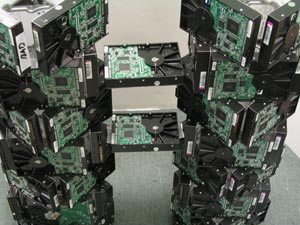Storage technology is experiencing remarkable growth, with the ability to double data density in just about 9 months. At this rate, by the end of 2007, desktop computers will be equipped with 1 terabyte (TB) hard drives, and laptops will support 200 GB drives.
 |
| Source: supergooddeal |
Recently, Hitachi Global Storage Technologies introduced a hard drive model measuring only 9 inches with a capacity of up to 1,000 GB, but stated that this product would take 20 years to perfect. “This is just a vision for the future, but the final product will not be much more expensive than current prices,” said Bill Healy, Vice President of Hitachi.
Although Hitachi’s project cannot be realized overnight, many companies such as Seagate, Western Digital, Hitachi, Samsung, and Toshiba are actively supporting and applying reliable technologies for their products.
According to Celeste Crystal, an analyst at market research firm IDC, manufacturers of flash storage devices have been able to fit more bits of data into each “cell” of the chip, while also utilizing new methods to increase the number of “cells” without enlarging the overall size.
Meanwhile, the capacity of hard drives with magnetic disks is also doubling at an almost yearly rate. After decades of increasing bit density, this industry has begun to encounter certain physical limitations and is transitioning to perpendicular recording technology, which allows information to be stored vertically rather than horizontally.
By the end of 2006, consumers will be greeted with computers and storage devices featuring 750 GB hard drives, a 50% increase from the current 500 GB, and this record will be broken the following year with a 1 terabyte drive. One TB allows for the storage of 375 hours of standard TV programming, 75 hours of high-definition video, over half a million photo files, or 10,000 music CDs.
Another record is that the hard drive industry achieved global revenues of $27.9 billion in 2005, and IDC predicts that by 2010, this sector will generate $41.5 billion. The flash segment is also expected to reach $18.7 billion in the next four years, up from $10.6 billion last year.
IDC notes that while flash technology is highly regarded, hard drives will still remain a crucial component in gaming consoles, automotive navigation systems, digital video recorders (DVRs), and handheld camcorders.
T.N.


















































